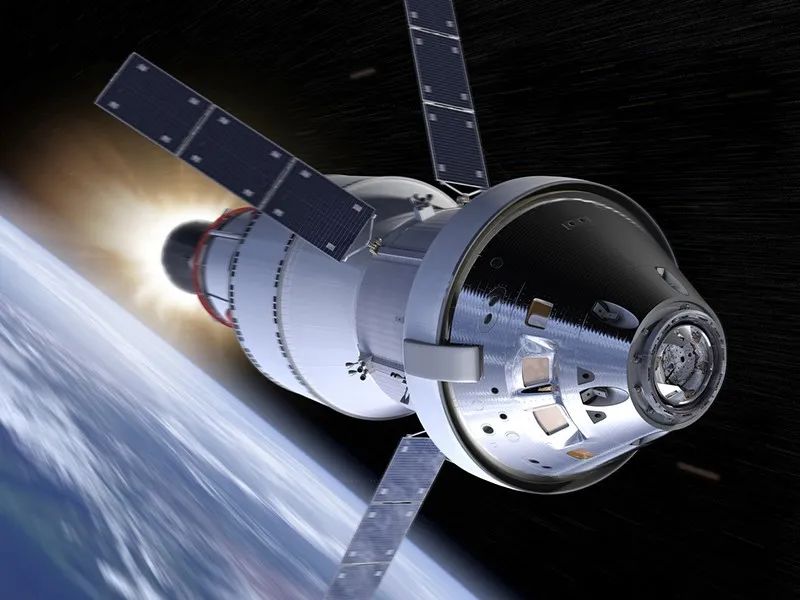For the first woman to land on the moon, the most powerful rocket in history is about to fly
Author:Journal of China Science Time:2022.08.26
Text | Wang Fang

During the "Artemis 1" flight, the "Orion" space cabin will fly over the moon and return to Earth 42 days later. Picture source: NASA
If everything is planned, the NASA (NASA) has the most powerful carrier rocket in history, the Space Launch System (SLS) will conduct the first test flight on August 29.
SLS will send a small space capsule that can carry astronauts into space. The space cabin called "Orion" will fly around the moon -flying farther than any spacecraft built for humans, and returns to the earth after 42 days.
This test flight is important because NASA plans to use the space capsule to send astronauts to the moon in the next few years. If it succeeds, this will be the first time that human beings have surpassed the near -ground track since the return of Apollo 17 astronauts in 1972.
"We have entered the new era of aerospace science research." The yeast genetic experiments of Luis Zea, a aerospace engineer at the University of Colorado, and other experiments will be conducted with this test flight. They were plugged into a astronaut seat on the "Orion" space cabin.
This approach is to maximize the use of this test flight that costs more than $ 4 billion. Some experiments will be carried out around the moon and then return; other experiments are deployed in space.
The other scientific loads of this flight include two small satellites drawing the moon ice map, Sun sails driving towards asteroids, and humanoid models that measure radiation how to affect the internal organs of the human body. One of them is a small lander from Japan, and it will even land on the moon -if successful, Japan will become the fourth country of soft landing moon.
The flight, known as "Artemis 1" this time, is the first step in the NASA "Artemis" plan. "Artemis 2" will be equipped with astronauts by 2024; "Artemis 3" will be equipped with an astronaut to land near the Moon Antarctica. This one is 2025 or later. The completed task will include the first female to land on the moon.
On the day of the launch of "Artemis 1", two solid rockets were provided by two solid rockets and 4 powerful engines. "Orion" space cabin is separated. The space capsule will use a smaller, made -made promotion system to enter the track of flying over the moon.
In the process, scientific experiments will start. Within hours after launch, the spacecraft will deploy 10 small cube satellites to space. But 5 of them have not been charged since the Rockets have been installed on the Rockets more than a year ago. Some researchers are worried that batteries may not be able to provide sufficient energy for cube satellites to start working as planned.
Assuming the deployment is successful, two cube satellites will draw the ice on the moon surface in different ways. NASA is interested in the moon ice because it preserves the frozen record of the history of the solar system and can be used as a resource for future human adventure.
The orbital aircraft has been proven, and it contains ice in the permanent shadow lunar meteorite pit. The goal of "Artemis 3" is to allow astronauts to land in Antarctica to study these ice. However, the current moon scientists do not know the exact position of ice, nor do I know how much ice is.
A cube satellite of "Artemis 1" will fly at low altitude over the moon's Antarctic, looking for water in the form of hydrogen. It will draw the most resolution of neutrons so far, indicating the location of the hydrogen. "This will tell us where Shui Bing is." Craig Hardgrove, the main researcher of the task of the State University of Arizona.
Another cube satellite will use infrared spectrometers to draw ice maps to find the characteristics of the moon surface water. It will supplement the above neutron map by providing another view of ice distribution.
The third cube satellite is Japan's lander, only 700 grams, which is also the smallest moon lander in the world.
It will fly directly to the surface of the moon and release a micro airbag buffer detector hundreds of meters above it. The detector will fall freely and hit the surface, and then try to communicate with the earth and measure the radiation environment.
There is also a cube satellite to go to a small planet called "2020 GE", not the moon. It will start a 86 -square -meter solar sail that uses the pressure of sunlight to sail in space. This flight will test new cameras and innovative methods for compression and transmission of deep space tasks.
The two human models Helga and Zohar will be tied to the seat of the "Orion" space cabin to board the "Artemis 1". The experiment was led by the German Aerospace Center, which aims to better quantify the impact of radiation on the human body.
"China Science News" (2022-08-26 The original title "Return to the Moon!" Artemis 1 "is about to fly"))
Edit | Zhao Lu
Capture | Zhihai

- END -
Live Trailer | "Civil Aviation Wisdom" fifth cloud network integration to empower the digital construction of civil aviation

On June 30, the fifth online meeting of Civil Aviation Wisdom will meet you. This ...
Baidu releases quantum computers: not bare metal, "use it as soon as possible"

Text | China Newspaper reporter Zhao GuangliLink the quantum computer with industr...